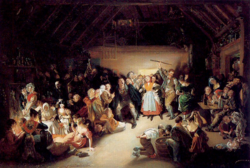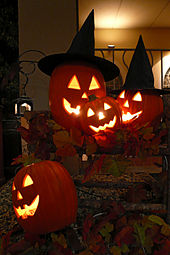Justin - Baby Dropping in India
Abby - Kurnai Australian Tribal Initiation
Megan - Indian Stupa Story
Zach - Rain
Jeremy Naab - Trick or Treat ;)
Juniper - "Est" Burial Custom
Antigone (Sophocles) Ἀντιγόνη
Expand on the Theban Legend Play.
HALLOWEEN!
(All Hallow's Eve) - Celebration of all souls, including the demons and the devils.
"History
Historian Nicholas Rogers, exploring the origins of Halloween, notes that while "some folklorists have detected its origins in the Roman feast of Pomona, the goddess of fruits and seeds, or in the festival of the dead called Parentalia, it is more typically linked to the Celtic festival ofSamhain, whose original spelling was Samuin (pronounced sow-an or sow-in)". The name of the festival historically kept by the Gaels and celts in the British Isles which is derived from Old Irish and means roughly "summer's end".
However, according to the Oxford Dictionary of English folk lore: "Certainly Samhain was a time for festive gatherings, and medieval Irish texts and later Irish, Welsh, and Scottish folklore use it as a setting for supernatural encounters, but there is no evidence that it was connected with the dead in pre-Christian times, or that pagan religious ceremonies were held." [4]
The Irish myths which mention Samhain were written in the 10th and 11th centuries by Christian monks. This is around 200 years after the Catholic church inaugurated All Saints Day and at least 400 years after Ireland became Christian. [4]
Origin of name
The word Halloween is first attested in the 16th century and represents a Scottish variant of the fuller All-Hallows-Even ("evening"), that is, the night before All Hallows Day.[5] Although the phrase All Hallows is found in Old English (ealra hālgena mæssedæg, mass-day of all saints), All-Hallows-Even is itself not attested until 1556.[5]
Symbols
Development of artifacts and symbols associated with Halloween formed over time. For instance, the carving of jack-o'-lanterns springs from the souling custom of carving turnips into lanterns as a way of remembering the souls held in purgatory.[6] The turnip has traditionally been used in Ireland and Scotland at Halloween,[7][8] but immigrants to North America used the native pumpkin, which are both readily available and much larger – making them easier to carve than turnips.[7] The American tradition of carving pumpkins is recorded in 1837[9]and was originally associated with harvest time in general, not becoming specifically associated with Halloween until the mid-to-late 19th century.[10]
The imagery of Halloween is derived from many sources, including national customs, works of Gothic and horror literature (such as the novelsFrankenstein and Dracula), and classic horror films (such as Frankenstein and The Mummy).[11] Among the earliest works on the subject of Halloween is from Scottish poet John Mayne in 1780, who made note of pranks at Halloween; "What fearfu' pranks ensue!", as well as the supernatural associated with the night, "Bogies" (ghosts), influencing Robert Burns' Halloween 1785.[12] Elements of the autumn season, such as pumpkins, cornhusks, and scarecrows, are also prevalent. Homes are often decorated with these types of symbols around Halloween.
Halloween imagery includes themes of death, evil, the occult, or mythical monsters. Black and orange are the holiday's traditional colors."
Kenosis ( κένωσις ) - Means an 'emptying out'
-tote tase (Plerosis)
Nacirema - "Most cultures exhibit a particular configuration or style. A single value or pattern of perceiving the world often leaves its stamp on several institutions in the society. Examples are "machismo" in Spanish-influenced cultures, "face" in Japanese culture, and "pollution by females" in some highland New Guinea cultures. Here Horace Miner demonstrates that "attitudes about the body" have a pervasive influence on many institutions in Nacirema society."
Metamorphosis: from Greek μετά meta and μορφή morphē, meaning "changes of shape"
The Eleusinian Mysteries
The Eleusinian Mysteries, held annually in honor of Demeter and Persephone, were the most sacred and revered of all the ritual celebrations of ancient Greece. They were instituted in the city of Eleusis, some twenty-two kilometers west of Athens, possibly as far back as the early Mycenaean period, and continued for almost two thousand years. Large crowds of worshippers from all over Greece (and later, from throughout the Roman empire) would gather to make the holy pilgrimage between the two cities and and participate in the secret ceremonies, generally regarded as the high point of Greek religion. As Christianity began to spread, the Mysteries were condemned by the early Church fathers; yet the rites continued for hundreds of years more and exercised considerable influence on the formation of early Christian teachings and practices.
Our sources of information regarding the Eleusinian Mysteries include the ruins of the sanctuary there; numerous statues, bas reliefs, and pottery; reports from ancient writers such as Aeschylos, Sophokles, Herodotus, Aristophanes, Plutarch, and Pausanias--all of whom were initiates--as well as the accounts of Christian commentators like Clement of Alexandria, Hippolytus, Tertullian, and Astorias. Yet for all this evidence, the true nature of the Mysteries remains shrouded in uncertainty because the participants did, with remarkable consistency, honor their pledge not to reveal what took place in theTelesterion, or inner sanctum of the Temple of Demeter. To violate that oath of secrecy was a capital offense. (Aeschylos, for example, once had to fear for his life on account of coming too close to revealing forbidden truths.) For these reasons, scholars today must make use of circumstantial evidence and inferences, with the result that there is still no consensus as to what did or did not take place. Hence, we shall sometimes be forced to engage in the tentative weighing of alternative hypotheses, without always reaching definite conclusions.





No comments:
Post a Comment